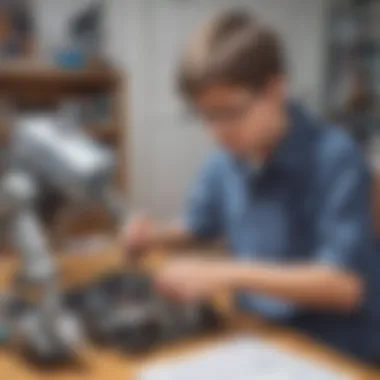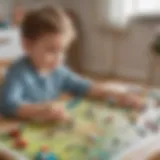Exciting Summer STEM Activities to Inspire Young Science Enthusiasts


Science Fun Facts
Prepare to embark on an exciting journey through the fascinating world of science! Did you know that the first computer virus was created in 1983, known as the "Elk Cloner"? Or that honey never spoils due to its low water content and high acidity levels? Explore quirky science stories like the time a chicken lived for 18 months without its head. Curious about amazing science records? The tallest tree in the world, Hyperion, stands at a staggering 379.7 feet - equivalent to a 35-story building! Ponder over thought-provoking questions such as why is the sky blue?
Discover the Wonders of Science
Unveil the mysteries of the universe by delving into various scientific concepts! Watch educational videos and animations showcasing the wonders of physics and biology. Use interactive learning tools to simulate complex scientific phenomena like volcanic eruptions or the water cycle. Discover the real-life applications of science in everyday scenarios, from the technology behind smartphones to the physics of roller coasters.
Science Quiz Time
Challenge your knowledge with engaging interactive quizzes! Test your understanding with multiple-choice questions covering topics from the solar system to chemical reactions. Stimulate your brain with brain teasers and puzzles that make learning fun. Explore learning through gamification, turning scientific concepts into exciting challenges for young learners.
Science Experiment Showcase
Get ready for hands-on fun with a showcase of thrilling science experiments! Follow step-by-step instructions to create erupting volcanoes, rainbow foam, or DIY slime. Check out the materials list to gather household items for your experiments, from baking soda to food coloring. Prioritize safety with essential tips and precautions, ensuring a secure and enjoyable scientific exploration!
Introduction
Importance of STEM Education
Benefits of STEM Learning
Among the core pillars of STEM education lies a treasure trove of benefits awaiting exploration by eager young learners. The intrinsic value of STEM learning manifests in its ability to nurture a multifaceted skill set, ranging from analytical reasoning to scientific inquiry. By engaging in STEM activities, children not only enhance their cognitive abilities but also cultivate a mindset attuned to innovation. The acquisition of these skills not only empowers students to excel academically but also equips them with the tools necessary to thrive in a rapidly evolving technological landscape. In essence, STEM learning serves as a conduit for holistic development, bridging the gap between theoretical knowledge and practical application.
Encouraging Critical Thinking Skills
Within the landscape of STEM education, the cultivation of critical thinking skills stands as a cornerstone of intellectual growth. By encouraging students to question, analyze, and evaluate information critically, STEM activities foster a robust framework for problem-solving. Through tasks that require logical reasoning and creative solutions, young learners are equipped with the acumen to navigate complexities with confidence and acuity. This emphasis on critical thinking not only sharpens cognitive faculties but also engenders a mindset conducive to adaptability and innovation, essential traits in an ever-evolving educational landscape.
Fostering Innovation and Creativity
At the heart of STEM education lies a profound emphasis on fostering innovation and creativity, virtues that spark ingenuity and pave the way for groundbreaking discoveries. Through hands-on experimentation and project-based learning, students are propelled into a realm where imagination converges with scientific principles. By nurturing a spirit of curiosity and exploration, STEM activities catalyze a passion for innovation, empowering young minds to envision and construct solutions to real-world challenges. In essence, the fusion of innovation and creativity within STEM education not only ignites enthusiasm but also cultivates a culture of problem solvers and trailblazers in the making.
Target Audience for Summer STEM Activities
Children aged 6-
Within the cohort of children aged 6-12 lies a reservoir of untapped potential waiting to be harnessed through engaging STEM activities. These formative years serve as a critical juncture where curiosity is at its peak and receptivity to new knowledge is paramount. By tailoring STEM activities to suit the cognitive capacities and interests of this demographic, educators and caregivers can provide a fertile ground for exploration and skill development. Through age-appropriate experiments and challenges, children aged 6-12 not only enhance their scientific acumen but also cultivate a passion for discovery that sets the stage for lifelong learning.


Parents Seeking Educational Resources
For parents seeking to augment their child's educational journey, Summer STEM Activities present a veritable goldmine of resources catering to diverse learning styles and interests. By actively engaging in their child's learning process, parents become facilitators of knowledge growth, imparting not only academic concepts but also fostering a love for learning. The availability of STEM activities designed for home-based implementation empowers parents to create enriching learning experiences tailored to their child's unique needs. Through this collaborative approach, parents play a pivotal role in instilling a lifelong love for STEM disciplines, setting the foundation for academic success and a thirst for knowledge.
Science Experiments
Science experiments play a pivotal role in fostering a deep understanding of scientific principles, encouraging curiosity and critical thinking skills. These hands-on activities not only make learning engaging but also cultivate a passion for exploration and discovery. Children aged 6-12 benefit immensely from participating in science experiments during the summer, as it sparks their interest in STEM subjects and nurtures their problem-solving abilities.
Kitchen Chemistry
In the realm of kitchen chemistry, the Baking soda and vinegar d include classic and mesmerizing volcanic eruptions that never fail to captivate young minds. The fizzing reaction between these two household ingredients serves as a captivating introduction to chemical reactions, demonstrating the principles of acid-base chemistry in a visually striking manner. Despite its elementary ingredients, the Baking soda and vinegar experiment remains a cornerstone of science education for its simplicity, affordability, and effectiveness in elucidating fundamental scientific concepts.
The Homemade slime extrerpiments fusing together everyday ingredients to create a colorful, squishy substance that intrigues young scientists with its tactile properties. This gooey creation not only introduces children to the concept of non-Newtonian fluids but also allows for endless variations, facilitating experimentation and exploration. Despite its messiness, Homemade slime experiments offer a hands-on approach to understanding polymers and cross-linking, making it a popular choice for engaging young learners in the world of chemistry.
Color-changing mikl_ arises as a magical and captivating experiment that demonstrates scientific phenomena through a familiar kitchen staple. By adding a drop of dish soap to a plate of milk and food coloring, children witness mesmerizing color transformations, leading to discussions about surface tension and molecular interactions. This visually stimulating experiment not only explores the properties of fat molecules and soap but also ignites curiosity about the scientific principles behind everyday occurrences.
Outdoor Exploration
Outdoor exploration provides a refreshing avenue for young scientists to connect with nature and observe the world around them. A Nature scavenger hunt_ offers a multisensory experience, encouraging children to utilize their observation skills and immerse themselves in the outdoors. The hunt not only promotes environmental awareness but also instills a sense of curiosity and appreciation for the natural world.
The Sunight and shadow observations_ shed light on the interplay between light sources and objects, prompting children to explore the concepts of light and shadow through hands-on activities. By tracing shadows throughout the day and noting the sun's position, young learners gain insight into the Earth's rotation and its effects on sunlight angles. This observational activity not only enhances children's scientific knowledge but also fosters an interest in astronomy and celestial mechanics.
The Plant life cycle studyo allows children to witness the growth process of plants firsthand, from seed germination to flowering and fruiting. By cultivating plants and observing their life cycles, young scientists learn about photosynthesis, pollination, and the interconnectedness of living organisms. This hands-on experience not only promotes botany knowledge but also cultivates a sense of responsibility and appreciation for the natural world.
Technology Projects
Technology projects play a pivotal role in engaging young minds with the wonders of STEM education. These projects not only introduce children to the fascinating world of technology but also nurture essential skills for the future. From learning coding to exploring robotics, technology projects offer a hands-on approach to problem-solving and creative thinking. They encourage children to think critically, analyze situations, and come up with innovative solutions. In the realm of STEM activities, technology projects stand out for their ability to blend theoretical knowledge with practical application.
Coding Adventures
Introduction to Scratch programming
Introducing young learners to Scratch programming is a significant step in their STEM journey. Scratch programming offers a user-friendly platform for kids to grasp the fundamentals of coding through visual blocks. This approach simplifies complex coding concepts, making it accessible and engaging for beginners. The drag-and-drop interface allows children to experiment with coding logic, fostering creativity and logical thinking. Scratch programming serves as an ideal starting point for young enthusiasts, laying a solid foundation for future exploration in computer science.
Building a simple website
Building a simple website exposes children to the fundamentals of web development. It enables them to understand the structure of a website, learn basic HTML, CSS, and design principles. Creating a website from scratch instills a sense of accomplishment and boosts confidence in young learners. It also provides insight into the digital realm, enhancing their technological literacy. Building a website encourages creativity, attention to detail, and an appreciation for user experience.


Creating interactive stories
Crafting interactive stories enhances children's storytelling skills while integrating technology. This activity combines creativity with technology, allowing kids to design narratives with branching storylines and interactive elements. Creating interactive stories sparks imagination, promotes sequence planning, and hones digital storytelling abilities. It cultivates skills in multimedia creation, graphics integration, and user engagement. By crafting interactive stories, young learners explore the narrative potential of technology and develop a unique form of expression.
Robotics Fun
Robotics projects introduce kids to the exciting world of automation and mechanical engineering. These projects not only enhance technical skills but also instill patience, perseverance, and problem-solving abilities. Engaging in robotics challenges provides hands-on experience in building and programming robots, fostering a deep understanding of engineering concepts. Robotics fun sparks curiosity, encourages teamwork, and cultivates a passion for innovation among young science enthusiasts.
Building a basic robot
Initiating children into building a basic robot lays the groundwork for understanding robotics principles. It involves assembling components, understanding circuitry, and basic programming concepts. Building a basic robot cultivates skills in engineering design, promotes logical thinking, and instills a sense of accomplishment. This activity nurtures creativity, attention to detail, and resilience in tackling technical challenges.
Programming robot movements
Programming robot movements involves coding commands to control a robot's actions. This aspect of robotics enhances logical reasoning, algorithmic thinking, and problem-solving skills in children. By exploring programming concepts through robotics, young enthusiasts learn to sequence instructions, debug code, and optimize robotic functions. Programming robot movements empowers kids to interact with technology in a tangible and practical manner, bridging the gap between theory and application.
Robotics challenges and games
Engaging in robotics challenges and games presents children with fun and stimulating activities to test their engineering skills. These challenges encourage strategic thinking, experimentation, and creativity. Robotics challenges expose young learners to real-world problems that require innovative solutions. By participating in robotics games, kids enhance their competitive spirit, teamwork abilities, and adaptability to technological challenges. Robotics challenges and games foster a spirit of exploration and discovery, fueling a lifelong passion for engineering and technology.
Engineering Challenges
Paper Engineering
Origami creations:
Origami creations within the context of STEM Design Projects hold a unique position due to their fusion of art and mathematics. Origami involves intricate paper folding techniques that enhance spatial reasoning and geometric understanding. Children are captivated by the transformation of a flat sheet into a three-dimensional masterpiece, allowing them to appreciate symmetry and precision in design. The tactile nature of origami nurtures fine motor skills and patience while stimulating creativity and attention to detail. Although origami appears delicate, it builds resilience and perseverance through trial and error, making it a valuable addition to this article.
Paper bridge building:
Considered a cornerstone of Engineering Challenges, paper bridge building introduces children to structural engineering principles in a hands-on manner. This activity encourages participants to explore load distribution, balance, and stability as they construct bridges using limited resources. The trial and error nature of this task empowers young learners to refine their designs iteratively, honing their problem-solving skills. Furthermore, paper bridge building sparks curiosity about architectural feats and inspires curiosity in civil engineering, making it a noteworthy inclusion in our STEM repertoire for budding engineers.
Marshmallow and toothpick structures:
Marshmallow and toothpick structures offer a fun and engaging approach to Engineering Challenges, blending creativity with structural integrity. This activity prompts children to experiment with different architectural designs using marshmallows as connectors and toothpicks as supports. Through this hands-on experience, kids learn about stability, balance, and the importance of structural support in construction. The tactile sensation of building with edible materials adds a sensory dimension to the task, enhancing the overall learning experience. Marshmallow and toothpick structures not only foster creativity but also provide a delectable twist to traditional engineering exercises, making learning both educational and delicious.
STEM Design Projects


Building a tower using household items:
Building a tower using household items merges engineering principles with resourcefulness, encouraging youngsters to think flexibly and creatively with everyday materials. This project emphasizes the importance of stability, height, and aesthetics in tower construction, prompting children to strategize and experiment to achieve desired results. By utilizing accessible resources, such as cups, straws, or newspapers, participants explore structural integrity and design considerations while honing their problem-solving abilities. Building a tower using household items instills a sense of accomplishment as children witness their creations rise steadily, promoting a growth mindset and a love for hands-on engineering challenges.
Creating a marble run:
Creating a marble run epitomizes the marriage of physics and creativity, inviting children to design pathways that guide marbles through twists, turns, and obstacles. This activity promotes understanding of gravity, momentum, and friction as youngsters experiment with different configurations to optimize marble speed and movement. Participants engage in iterative design processes, refining their tracks to enhance marble performance and overcome design challenges. Creating a marble run not only stimulates imagination and problem-solving but also instills patience and perseverance as children test and refine their creations to achieve successful and exciting marble journeys.
Designing a cardboard maze:
Designing a cardboard maze amplifies spatial reasoning and logic skills, challenging children to create intricate pathways that test problem-solving abilities and direction-following skills. Encouraging experimentation with dead-ends, loops, and secret passages, this activity sparks creativity and strategic thinking as participants design engaging mazes for others to navigate. Children delve into the psychology of problem-solving by anticipating user behavior and adjusting maze layouts accordingly. Designing a cardboard maze not only hones critical thinking but also fosters collaboration and communication as players share and navigate each other's creations, making it an enriching addition to our STEM Design Projects.
Mathematical Puzzles
Mathematical puzzles play a critical role in fostering logic and problem-solving skills in young minds. These puzzles offer a practical way to engage children in mathematical concepts while honing their analytical abilities. By incorporating mathematical puzzles into summer STEM activities, children not only have fun but also develop a deeper understanding of mathematical principles. One of the key benefits of mathematical puzzles is their ability to enhance cognitive functions and promote a growth mindset in children. Moreover, these puzzles encourage perseverance and critical thinking, essential skills for future academic and real-world success.
Number Games
Sudoku Challenges
Sudoku challenges, with their focus on logic and pattern recognition, are a popular choice for enhancing mathematical skills in young learners. The intricacy of Sudoku puzzles encourages children to think strategically and methodically, honing their problem-solving capabilities. One of the key characteristics of Sudoku challenges is their ability to stimulate logical thinking and improve concentration levels. These challenges provide a structured approach to number placement, developing children's numerical fluency and decision-making skills. While Sudoku challenges offer numerous cognitive benefits, some may find them challenging initially, requiring patience and perseverance to master.
Math Bingo
Math Bingo is a dynamic and interactive way to reinforce basic mathematical concepts while engaging children in a fun and entertaining game. The key characteristic of Math Bingo lies in its ability to combine learning with exciting gameplay, making it a popular choice for educators and parents alike. This activity not only enhances number recognition and computation skills but also promotes social interaction and teamwork among participants. The unique feature of Math Bingo is its adaptability to different skill levels, allowing children to progress at their own pace while enjoying the learning process. However, some may argue that the randomized nature of Bingo may limit focused learning in comparison to structured math exercises.
Pattern Recognition Activities
Pattern recognition activities serve as a creative way to develop children's cognitive abilities and enhance their spatial awareness. These activities involve identifying and predicting patterns, honing children's visual perception and reasoning skills. The key characteristic of pattern recognition activities is their focus on visual intelligence and problem-solving through pattern analysis. By engaging in these activities, children learn to recognize sequences and relationships, improving their critical thinking and analytical skills. The unique feature of pattern recognition activities is their applicability in various disciplines, fostering a holistic approach to problem-solving. Despite these benefits, some children may find pattern recognition activities challenging initially, requiring guidance and practice to master.
Geometry Adventures
Exploring Shapes Through Tangram Puzzles
Exploring shapes through tangram puzzles introduces children to the world of geometry in a hands-on and engaging manner. The key characteristic of tangram puzzles lies in their ability to enhance spatial reasoning and geometric understanding. By manipulating geometric pieces to form specific shapes, children develop a concrete understanding of geometric concepts and problem-solving strategies. The unique feature of tangram puzzles is their versatility in promoting creativity and spatial visualization skills in children. While tangram puzzles offer a visually stimulating way to learn geometry, some may find the spatial transformations challenging at the beginning, requiring persistence and experimentation to grasp.
Geometric Art Creations
Geometric art creations combine mathematical principles with artistic expression, providing a platform for children to explore geometry through creativity. The key characteristic of geometric art creations is their integration of mathematical concepts into visually appealing artworks, encouraging children to see beauty in complexity. By creating geometric art, children not only enhance their understanding of shapes and symmetry but also develop their artistic skills and imaginative thinking. The unique feature of geometric art creations lies in their ability to bridge the gap between mathematics and art, fostering a multidisciplinary approach to learning. However, some may face challenges in translating abstract geometric concepts into concrete art forms, requiring guidance and experimentation to unleash their creative potential.
Measuring and Comparing Angles
Measuring and comparing angles provide children with a tangible way to understand geometric properties and spatial relationships. The key characteristic of measuring and comparing angles is their focus on precision and accuracy, essential skills in geometric analysis. By using tools such as protractors, children learn to quantify angles and distinguish between acute, obtuse, and right angles. The unique feature of measuring and comparing angles is their practical application in real-world scenarios, from architectural design to navigation. While this activity enhances children's geometric knowledge and measurement skills, some may find the abstract nature of angles challenging, requiring hands-on experience and visualization techniques to master.







